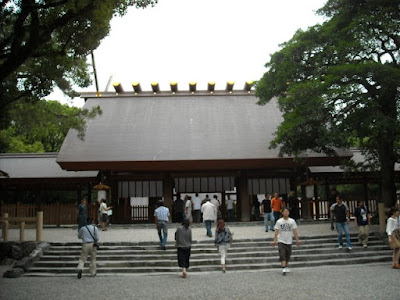 |
| The large performance hall. |
First, we walked through the museum. This area of Japan is famous for its swordsmaking, and we looked at many ancient and fearsome examples. Supposedly, the Kusanagi no Tsurugi, or "Grasscutter Sword," is also at this museum, but it is never seen. In ancient lore, it was a gift from Susano-o (the God of Storms) to Amaterasu (the great Goddess of Japan), as payment for a previous indiscretion. I can't cover it all here, so go read more about it! Maybe it's real, maybe not.

 |
| The small performance hall. |
 |
| Walking up to the main shrine. |
 Something really cool about the Shinto religion: anything from nature that is large and impressive is a God. To the left is pictured a rather formidable tree that grew in the middle of the shrine grounds. It is decked out in shrine symbols, denoting it as a God and a place to worship. People come and pray before it, asking for health, good fortune, etc.
Something really cool about the Shinto religion: anything from nature that is large and impressive is a God. To the left is pictured a rather formidable tree that grew in the middle of the shrine grounds. It is decked out in shrine symbols, denoting it as a God and a place to worship. People come and pray before it, asking for health, good fortune, etc. 
The little dude to the right is apparently a monument to glasses... or at least that's how Matt's translated the kanji. I quite liked him. This style of statue isn't common in this area of Japan, and I always enjoy seeing sights that are different than expected.


Here are two shots of lesser shrines on the Atsuta grounds. To the left, a gate showered with small torii. To the right, an idyllic gate to a complex of a small southern shrine.
But wait! Lest we forget what's truly important in society: behold, the Japanese tween girl pop idol group.


Comments
Post a Comment